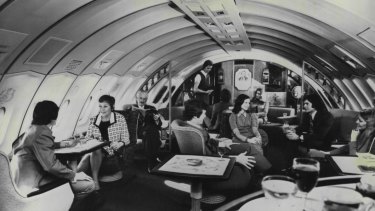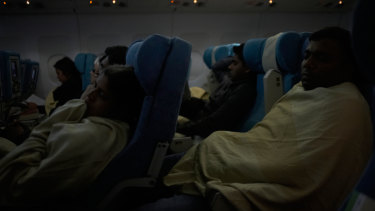Why different classes on an aircraft increase the likelihood of misbehaviour
Flying has increasingly become a world of the haves and have-nots, starting with purchasing a ticket and continuing as passengers are sorted by status to board.
Once on the plane, passengers can see where they fit in the hierarchy, with the seats getting smaller and thinner and leg-room tighter with each passing row. Then, there's the scramble to secure space in the overhead bins. "By the time you walk down the jet bridge, you are a bundle of nerves," says Henry Harteveldt, founder of Atmosphere Research Group, a travel analysis firm in San Francisco.
Living it up in the lounge of a Qantas plane in 1971.
Now, some researchers are arguing that the stresses of flying — and they say income inequality is among them — contribute to an increase in unruly behaviour on planes.
The International Air Transport Association, an industry trade group with about 290 member airlines, found that there was one disruptive incident for every 1053 flights in 2017, the last year for which data was available. In 2016, there was one incident for every 1424 flights.
And every incident can affect passenger and flight safety. In some cases, pilots turn planes around, creating major delays.
"Airplanes are the physical embodiment of a status hierarchy," says Keith Payne, a professor of psychology and neuroscience at the University of North Carolina at Chapel Hill and the author of The Broken Ladder: How Inequality Affects The Way We Think, Live and Die.
"They are a social ladder made of aluminum and upholstery in which the rungs are represented by rows of boarding groups and seating classes."
Trying to sleep in an economy class cabin.Credit:Alamy
"Crowding," Payne adds, "is a risk factor for aggression, and more people in a small space make that more likely to happen."
One general option when an interaction starts to escalate, he noted, is to walk away and cool off. But, he said, on a plane there are few escape routes.
A study, published in 2016, found that multiple classes on an aircraft increased the likelihood of misbehaviour. The study, "Physical and Situational Inequality on Airplanes Predicts Air Rage," by Katherine DeCelles, now at the University of Toronto, and Michael Norton, at Harvard Business School, was published in the Proceedings of the National Academies of Sciences.
The authors found that the presence of a first-class cabin, in addition to an economy-class cabin, was associated with more frequent air rage incidents. And boarding through the first-class cabin rather than the mid-section of a plane increased those incidents.
The air transport association found that disruptive incidents fell into several categories; the most common were ignoring safety regulations, excessive drinking before a flight and smoking. The association also had reports of more severe disruptions, including physical aggression and damage to equipment.
It's far too easy for unruly events to occur, Harteveldt says.
Now, British and European Union organisations are starting programs to minimise disruptions. "No one wants to be next to that passenger who has consumed too much alcohol or is aggressive or rude due to other reasons," says Henk Van Klaveren, head of public affairs at the Airport Operators Association in London.
In July, the Airport Operators Association, the UK Travel Retail Forum and the air transport association (and later, Airlines UK) introduced a media campaign to curb excessive drinking. Called One Too Many, the program is expected to return this northern summer.
The campaign began at 10 airports (14 now participate, including London Heathrow) with airport screens and posters and a leaflet distributed by the police. It also appeared on Facebook, Instagram and Snapchat.
Bars and restaurants eliminated shots and two-pints from their menus. World Duty Free shops, a subsidiary of retailer Dufry, voluntarily introduced sealed bags to carry alcoholic purchases at 24 airports in Britain.
The One Too Many campaign "reminds passengers of their responsibilities and the severe consequences of drinking to excess," says Karen Dee, chief executive of the Airport Operators Association. "These consequences range from being denied boarding to unlimited fines, flight bans and prison sentences for the most serious offences."
The campaign is showing decreases in alcohol-related offenders at airports in Glasgow, Manchester and Birmingham, according to the operators association.
Beginning in April, the European Union Aviation Safety Agency and the airline transport association started a separate campaign on social media and YouTube. That campaign, #NotOnMyFlight, is intended to draw attention to rowdy behaviour.
The 28 EU member states and four associate states — Iceland, Norway, Liechtenstein and Switzerland — participate voluntarily. A video, created for dramatic effect, shows a passenger dancing in an aisle, another tossing an inflatable toy and luggage from the overhead bin and a third smoking in a lavatory. Each vignette intersperses a mug shot of the passenger with a designated punishable offence.
"The campaign is to remind passengers that each has the responsibility to behave in the correct manner when they fly," a spokesman for the aviation safety agency says.
One of the more extreme incidents occurred on a Ryanair flight from Dublin to Malta at the end of April. Fights broke out, and inebriated passengers danced on seats and abused the flight crew.
The crew requested police assistance while in flight and, when the plane landed, the police removed and detained some of the passengers. "We will not tolerate unruly or disruptive behaviour at any time, and the safety and comfort of our customers, crew and aircraft is our No. 1 priority," the airline said in a statement. "This is now a matter for the local police."
The police in Malta said two 23-year-old male passengers had been arraigned before a magistrate. They were accused of boarding an aircraft when drunk, acting in a manner likely to endanger an aircraft or any person and interfering with the aircraft crew's ability to perform its duties. Each was fined 1500 euros, or about $2400.
In March, two hours into a Hawaiian Airlines flight from Honolulu to Los Angeles, two passengers started quarrelling in the aisle. Flight attendants tried to move one to another seat.
The pilot enforced security procedures and returned to Oahu. When the plane landed, the flight attendants were treated for injuries, and the passengers who had been fighting were taken into custody. The aircraft finally arrived in Los Angeles five hours late.
What an airline considers acceptable behaviour is outlined in its contract of carriage. This document is available online, at airline ticketing facilities or by request from customer service. Contracts may be different for domestic and international flights.
An international effort is underway to adopt broader regulations to handle passenger disruptiveness, called the Montreal Protocol 2014.
Currently, a serious offence is tried according to the law of the aircraft's country of registration. The new regulation would consider whether a serious offence had been committed regardless of national registration. Jurisdiction over disruptive passengers would extend beyond the country where the aircraft is registered, to include the destination country. The treaty requires 22 countries for ratification. So far, 19 have ratified it.
The agreement adds provisions to recover costs from unruly passengers, says William O'Connor, a partner at the law firm Cooley in San Diego whose practice includes aviation matters. "There are issues of proof," he says, "and airlines are reluctant to involve customers as witnesses."
There is no timetable for the international treaty to go into effect. "You can't force signatories or put them on the clock," he says.
Yet, "airlines keep crowding people in the same amount of space and keep adding gradations in the space," says Payne of the University of North Carolina, even as they create social norms about appropriate flight behaviour.
The New York Times
Source: Read Full Article




